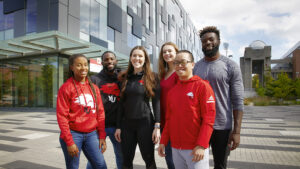How virtual assistant communications happens at York University
By Sharon Aschaiek | November 23, 2022

When students at York University have questions about resources, people and places on campus, they can turn to SAVY.
Full of information and always available, SAVY is ready to serve. SAVY is also a virtual assistant—but you might not know it from how prompt and personable its answers are. That’s because the “voice” of this VA was Tina Dealwis, former content specialist within the Division of Students.
“We try to make SAVY’s answers conversational and fun, and use a lot of humour, informal language and emojis to make it feel like students are talking to a friend or upper-year student,” says Dealwis, a former member of the division’s Communications and Marketing team.

York introduced SAVY in January 2020 as a wayfinding tool to better support its 50,000 students. One of a few such digital tools in operation at a university in Canada, the chatbot was developed through a partnership with IBM and is based on its Watson Assistant. To build buzz about the new VA, York held a contest inviting students to name it, and attracted 1,544 entries from 733 students.
Dealwis created and optimized content for SAVY while AI architect Vidur Kalive takes care of its technical operations, and both are guided by Nick Valentino, program manager of student success initiatives. Recently, they presented on SAVY’s development and its benefits to students during the pandemic at the SEMM Forum.
SAVY can answer questions on more than 500 topics, including academic advising, registrarial and financial services, important dates and deadlines, wellness resources, career support, campus events, even where to grab a bite. On average, it responds to up to 500 questions a week—though at peak times, e.g. during the start of the academic year, that number can reach 1,500.
While Dealwis is an experienced communicator in higher education and beyond, writing for a VA has its own distinct rules. What has been helpful is following the guide provided by IBM for shaping the tone of SAVY’s content, as well as research she has conducted to understand VA communications, but she says she has mostly learned on the job.
“Over time, as I got more used to SAVY, I sort of gave it my own spin—still following the correct tone and voice, but adding a little bit of my personality to it as well,” Dealwis says.
As for the subjects, Dealwis consulted with subject matter experts as well as other communicators across the institution to develop responses about the most pertinent topics, including those most commonly asked about by students. The goal is to create answers that either provide students with the information they need, or direct them to the appropriate department at York that can help them further.

Each week, the SAVY team reviews SAVY’s performance to determine whether its preprogrammed content is current and sufficient. To stay relevant to students and adapt to changing circumstances on campus, existing responses may need to be revised and new responses may need to be added. Overall, SAVY’s responses to questions hit the mark about 84% of the time, and the team strives to increase that success rate, as well as measure its impact on student service.
“We want to better understand the effectiveness of SAVY and how well it serves students. For instance, if it refers a student to academic advising, did they actually go on to book an appointment?” says Valentino, noting that this measurement work is partly happening through student surveys and focus groups.
As a communicator, Dealwis enjoyed the challenge of continually refining content for SAVY so that it best serves the needs of students.
“Being the voice of SAVY was the most fun that I’ve had at any job. I’m proud of what we’ve accomplished and how the VA has grown,” she says. “We’ve had students give us really positive feedback, and some have said they didn’t realize they were talking to a bot. So it’s rewarding to know that SAVY is making an impact and helping students.”